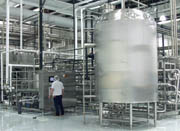
To paraphrase Douglas MacArthur, food engineers never die, they just become subcontractors. Two decades into the outsourcing trend in food manufacturing, the number of engineers on plant payrolls is down sharply. Platoons of specialists have given way to skeleton staffs that serve as jacks-of-all-trades and project managers. The suppliers they oversee, however, are likely to be former colleagues or counterparts at other food and beverage companies. Their expertise is still a valuable commodity and in demand, but employers would rather pay for it on an as-needed basis.
Devising new products and getting them onto store shelves as quickly as possible has replaced lowest-cost production as the core competency of many food manufacturers, suggests Burt Young, a food engineer with Lockwood Greene in Cincinnati. As a result, staffing dollars are thrown at food scientists and formulation experts, with a corresponding reduction in in-house engineering.
"When I was at General Foods, I had a big tent," Young recalls. "Now the challenge is keeping the right product in the marketplace. Companies rely on A/E firms to fill the engineering gaps for essential services that are not core."
"There are food companies that have outsourced to the point where they have no competency to bring to the equation at all, and that is fine with them," observes James Getchell, recently retired vice president of engineering at General Mills. "Even General Mills outsourced up to 75 percent of its engineering." But the grain-foods giant jealously safeguards "the underlying knowledge and the practical experience in applying its core competencies. Over an extended period of time, that process expertise enables you to become very efficient."
Expertise in process control and the methods and practices that give a manufacturer a competitive advantage should never be outsourced, Getchell adds. Raw material handling is less likely to be unique to a plant, so that function can be outsourced. Similarly, civil construction, pipe fitting and other commoditized skills are best left to outside specialists. "The last thing that people have sent outside is their process technology, and right behind that is packaging technology," he says. "There is a lot of learned competitiveness in those areas."
In the era when food manufacturers built new facilities yearly, staff engineers who could specify and bid every aspect of the project were justified, adds Darryl Wernimont, a director with the Haskell Co. "With new plant projects coming up every five or 10 years now, it's too costly to maintain the expertise in house. As a result, you saw a movement of people who were with the food companies into A/E firms to handle projects for multiple manufacturers."
Nestle Waters North America has engaged in one of the most aggressive new-plant building programs in recent years, but even that organization outsources construction responsibilities. New plants adhere to the Leadership in Energy and Environmental Design principles set forth by the United States Green Building Council. "Green-certified buildings require new learning and a whole new project approach," Wernimont says. "Instead of developing it in house, companies prefer to work with a firm that can guarantee the facility will be built correctly and operate as advertised."

USS O.J.
While core competency strategies usually involve peeling away non-critical functions, they also can lead to the acquisition of new areas of technical expertise. A dramatic example is the outfitting of ocean-going freighters as floating aseptic tank farms.Americans consume more orange juice than Florida citrus trees can supply, and a sizable import business of Brazilian orange juice has developed since the 1980s. For years it arrived as frozen concentrate, a declining-some say dying-part of the market. Consumers have embraced the convenience and perceived quality advantage of not-from-concentrate (NFC) orange juice. NFC's premium price point can support higher transportation costs, and Tropicana challenged suppliers to deliver Brazilian NFC juice in sufficient quantities to support the burgeoning market. Those suppliers possessed core competency in frozen bulk shipments, but meeting higher demand meant acquiring competency in aseptic bulk storage.
Brazilian processors Citrosuco Paulista SA and Sucocitrico Cutrale Ltd. retrofitted a total of three tanker ships to handle both frozen concentrate and NFC. Capacities fell short of demand, however, and in 2001 Citrosuco launched the M/V Carlos Fischer, a four-hold refrigerated ship with 16 vertical tanks capable of holding 500,000 gallons each. Carlos Fischer was joined by M/V Premium do Brasil 12 months ago, giving Citrosuco the ability to deliver NFC at ports of call in the U.S., Belgium, Japan and Korea.
"Building a tank farm in a mobile environment required some modifications, such as beefier collars and thicker metals," says Doug Nicol, general manager of Citrosuco's distribution operation at the Port of Wilmington, Del. The basic technology was developed 30 years ago by Phillip Nelson of Purdue University, with modifications to adapt the tank system for an ocean-going vessel executed by Enerfab Inc. "Tank construction itself isn't materially different" than the million-gallon land-based units that store aseptically processed NFC for up to a year, according to Nelson, "but getting them into a ship big enough to transport them was a challenge."
The 672 ft. long Premium do Brasil draws to a depth of 31 ft. and is serviced with an ammonia refrigeration system that maintains aseptic product at temperatures between freezing and 35°F. Frozen concentrate in other holds of the ship are held at 17°F.
Ironically, European consumers are the beneficiaries of this American technology, not U.S. juice lovers. Citrosuco's facilities in Manatee, Fla., and Wilmington, where 5.8 million gallons can be stored, lack aseptic transfer systems. Any NFC that is offloaded must therefore be reprocessed.
Citrosuco's investment in aseptic competency is paying off. "It's a significant expense to get into," Nicol allows, "but there's enough of a margin to support that expense." The same is true for Cutrale, which is a key supplier to Coca-Cola's Minute Maid division. One of the firms' biggest competitors is Cargill, which commands about 13 percent of the market. Cargill recently announced the sale of its Brazilian juice operations to Citrosuco and Cutrale, pending regulatory approval. Many issues factored into Cargill's decision, but the enhancement of core competencies by Citrosuco and Cutrale certainly played a role in their emergence as the world's two largest citrus juice suppliers.
Working on a considerably smaller aseptic stage is American Purpac Technologies, a recent start-up copacking operation in Beloit, Wis. Food service and bottling operations are Purpac's primary focus, and the ability to bulk blend as well as aseptically process and package liquid ingredients is the firm's distinction.
Purpac founder Scott Eckman is a second-generation food processor whose previous experience included a Chicago area firm with one of the first aseptic bag-in-box filling operations. The concept at Purpac is to receive tanker quantities of juices and other low-viscosity fluids, then aseptically process and package the contents in shelf-stable totes ranging from 5 to 260 gallons. The copacker is targeting blended products that typically are placed in frozen storage until final bottling. By rendering them shelf stable, beverage clients will realize supply-chain cost savings, boost product quality and improve ingredient security through aseptic's closed loop process, according to Purpac president Dave Madden.

Competence in refrigeration, particularly ammonia-based technology, may be an area where the pendulum is swinging back from outsourcing to in-house expertise, suggests Lockwood Greene's Young. "Clarence Birdseye built an industry based on efficient freezing, but some of the newer people in the industry have lost sight of the importance of that technology," he says.
"You need to keep at least one expert in house in areas such as refrigeration just to be sure you're not being sold a bill of goods by outside experts," agrees Getchell.
"Over the last 15 to 20 years, companies have relied increasingly on refrigeration specialists, with boiler and steam-system experts right behind them," observes Chris Jarc, project manager with Hixson Co. and a former project engineer and plant manager at meat and cereal plants. "Companies are not going to hire a refrigeration engineer, but they are taking the people they have and making them more qualified to read the manuals and monitor control screens."
Safety issues in ammonia systems must be addressed internally and cannot be outsourced, all agree. On the other hand, knowing how to shut down the system in an emergency does not imply maintenance expertise. "The staff refrigeration person has to become smarter, but he's not the guy who is going to weld pipe or add insulation," says Jarc.
Some of the skill sets that food manufacturers have outsourced are unlikely to ever return to the internal staff's umbrella. However, that doesn't preclude the addition of new technologies to the staff's areas of expertise. Core competency is not a static state, after all. It is fluid, and the skills it encompasses change from time to time and from company to company, depending on how much capital they want to invest in their human assets.
For more information:
Dave Madden, American Purpac Technologies, 608-362-5012
Jeff Raasch, Enerfab Inc., 513-641-0500
Darryl Wernimont, Haskell Co., 904-791-4500,
darryl.wernimont@thehaskellco.com
Chris Jarc, Hixson, 513-241-1230
Burt Young, Lockwood Greene